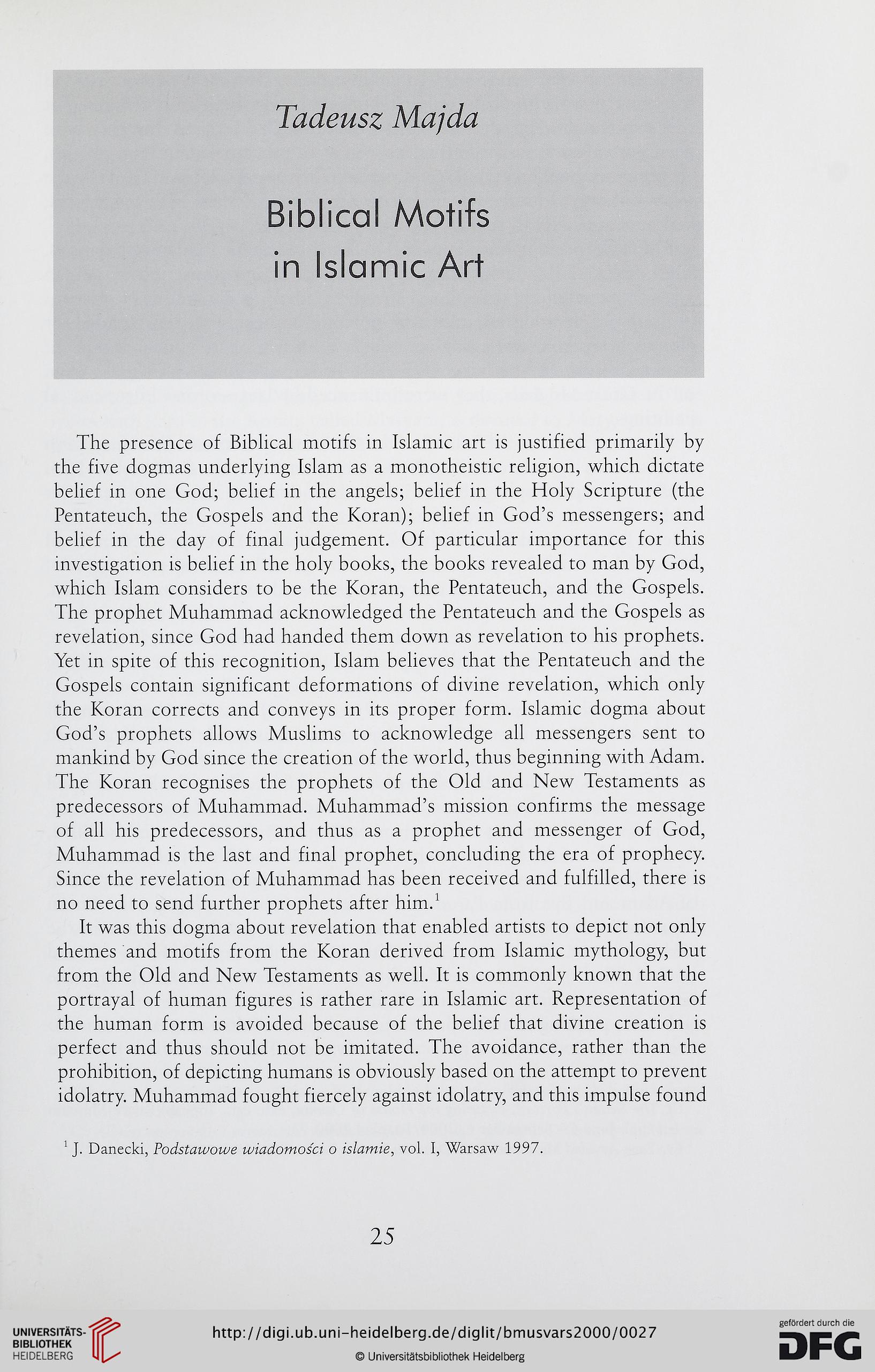Tadeusz Majda
Biblical Motifs
in Islamie Art
The presence of Biblical motifs in Islamie art is justified primarily by
the five dogmas underlying Islam as a monotheistic religion, which dictate
belief in one God; belief in the angels; belief in the Holy Scripture (the
Pentateuch, the Gospels and the Koran); belief in God’s messengers; and
belief in the day of finał judgement. Of particular importance for this
investigation is belief in the holy books, the books revealed to man by God,
which Islam considers to be the Koran, the Pentateuch, and the Gospels.
The prophet Muhammad acknowledged the Pentateuch and the Gospels as
revelation, sińce God had handed them down as revelation to his prophets.
Yet in spite of this recognition, Islam believes that the Pentateuch and the
Gospels contain significant deformations of divine revelation, which only
the Koran corrects and conveys in its proper form. Islamie dogma about
God’s prophets allows Muslims to acknowledge all messengers sent to
mankind by God sińce the creation of the world, thus beginning with Adam.
The Koran recognises the prophets of the Old and New Testaments as
predecessors of Muhammad. Muhammad’s mission confirms the message
of all his predecessors, and thus as a prophet and messenger of God,
Muhammad is the last and finał prophet, concluding the era of prophecy.
Since the revelation of Muhammad has been received and fulfilled, there is
no need to send further prophets after him.1
It was this dogma about revelation that enabled artists to depict not only
themes and motifs from the Koran derived from Islamie mythology, but
from the Old and New Testaments as well. It is commonly known that the
portrayal of human figures is rather rare in Islamie art. Representation of
the human form is avoided because of the belief that divine creation is
perfect and thus should not be imitated. The avoidance, rather than the
prohibition, of depicting humans is obviously based on the attempt to prevent
idolatry. Muhammad fought fiercely against idolatry, and this impulse found
1 J. Danecki, Podstawowe wiadomości o islamie, vol. I, Warsaw 1997.
25
Biblical Motifs
in Islamie Art
The presence of Biblical motifs in Islamie art is justified primarily by
the five dogmas underlying Islam as a monotheistic religion, which dictate
belief in one God; belief in the angels; belief in the Holy Scripture (the
Pentateuch, the Gospels and the Koran); belief in God’s messengers; and
belief in the day of finał judgement. Of particular importance for this
investigation is belief in the holy books, the books revealed to man by God,
which Islam considers to be the Koran, the Pentateuch, and the Gospels.
The prophet Muhammad acknowledged the Pentateuch and the Gospels as
revelation, sińce God had handed them down as revelation to his prophets.
Yet in spite of this recognition, Islam believes that the Pentateuch and the
Gospels contain significant deformations of divine revelation, which only
the Koran corrects and conveys in its proper form. Islamie dogma about
God’s prophets allows Muslims to acknowledge all messengers sent to
mankind by God sińce the creation of the world, thus beginning with Adam.
The Koran recognises the prophets of the Old and New Testaments as
predecessors of Muhammad. Muhammad’s mission confirms the message
of all his predecessors, and thus as a prophet and messenger of God,
Muhammad is the last and finał prophet, concluding the era of prophecy.
Since the revelation of Muhammad has been received and fulfilled, there is
no need to send further prophets after him.1
It was this dogma about revelation that enabled artists to depict not only
themes and motifs from the Koran derived from Islamie mythology, but
from the Old and New Testaments as well. It is commonly known that the
portrayal of human figures is rather rare in Islamie art. Representation of
the human form is avoided because of the belief that divine creation is
perfect and thus should not be imitated. The avoidance, rather than the
prohibition, of depicting humans is obviously based on the attempt to prevent
idolatry. Muhammad fought fiercely against idolatry, and this impulse found
1 J. Danecki, Podstawowe wiadomości o islamie, vol. I, Warsaw 1997.
25





